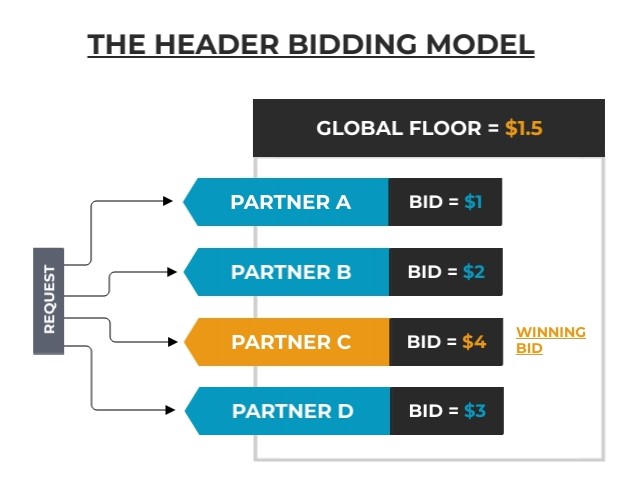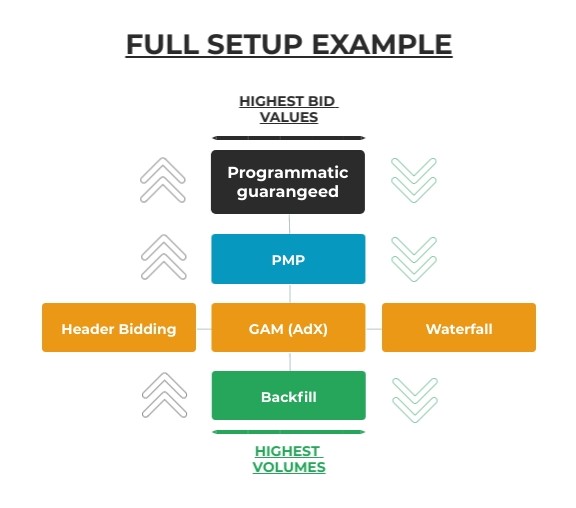What is header bidding?
Header Bidding is an advanced programmatic strategy that allows publishers to sell their website inventory for several ad exchanges simultaneously before making calls to their ad servers. It is also known as advanced bidding or pre-bidding technology.
Header bidding is a special type of programmatic auction and probably the most important monetization method in digital publishing today. When it comes to advertising technology, there have been countless developments over the years and if you run a Google search you’ll probably find that this is one of the most frequently discussed ones. Put simply, header bidding enables multiple advertisers to bid for an impression at the same time, instead of sequentially, helping to increase competition, fill, and ultimately revenue. Header bidding is technologically quite complex, so webmasters with limited coding expertise can have difficulties with both understanding and implementing the concept. While all the resources available are definitely helpful, publishers are more often than not left confused rather than informed. Let’s break it down.
How does header bidding work?
Now we know header bidding enables simultaneous auctions from multiple bidders. The key component enabling all of this is that the auction needs to take place outside of the publisher’s ad server, more specifically in the browser itself. As the name suggests, the code is placed in the website’s header and bids are collected before any other monetization processes have been initiated.
How does header bidding Differ from traditional Waterfall methods?
The traditional waterfall method has a vertical structure, meaning that bids would be requested from select marketplaces in a predetermined order until one of them matches or exceeds the floor price. The order in which partners are chained together and the respective floor prices are usually established based on each one’s average performance historically. This system is flawed, due to the fact that you have no control over how each individual impression is sold and rely only on the overall statistics. In comparison, header bidding has a horizontal structure – all buyers that are allowed to bid for the inventory do so simultaneously. That way partners are competing based on each individual bid and the auction is ‘fair’. Only after the winning bid is established does that go through to the ad server. In short, there’s no money being left on the table.
Let’s see the two situations illustrated to get some clarity:
Figure 1. Waterfall setup

As you can see, in this case, the winning bid goes to the first partner called who happens to exceed the floor price. However, in many situations, it’s possible for bids further down the line to be greater than what the auction closes at, which means that publishers are missing out on revenue.
Figure 2. Header Bidding

In contrast with the previous example, as mentioned earlier, a header bidding auction is flat. This ensures that the winning party is the one with the highest bid, not just the one that’s given the chance to go first. A floor price can still be applied so that you can avoid underselling premium inventory.
Another benefit to header bidding is that it increases publishers’ fill rates overall. Providing the first look of the inventory to all parties means that you open up possibilities for advertisers that are reluctant to go through the scraps at lower tiers. There’s also header bidding specific demand sources that are otherwise unavailable, which respectively increases competition. You may think it sounds fantastic so far, and it is, but there are also several drawbacks, which we will cover later on.
Pros
- More Competition as more buyers means more chance to match an impression with a higher value bid
- Control as publishers can choose the bidders that can take part in the header auction and have them compete on a level playing field
- Increased Fill especially at higher values, as exposure to more bidders also increases the chances of getting a bid on every impression, pushing up fill rates and eCPMs with them
- Fewer Discrepancies in reporting as only a single auction happens in a header bidding scenario
- Increased Transparency means bidders can make informed decisions after knowing the inventory and the prices
- Better Cookie Matching as the highest CPMs are often reserved for the customers already known to the bidders, therefore, providing more opportunities for remarketing monetization
Cons
- Latency Issues persist as adding more scripts to the header of a page slows down its load time, which has a negative effect on the user experience, results in fewer impressions loading, and lowers the likelihood of ads being viewed
- Demand Partners’ Limitations occur as although you can choose as many bidders as you like, the bid requests are sent all at once. Browsers only allow for a certain amount of those to go out simultaneously. This consequently puts a limit on how many bidders you can have active in the header auction.
- Technical Resource is very much needed and can be overwhelming for publishers. Implementation, customization and the need to operate appropriate Timeouts and Price Floors as well as ensuring all technologies are compatible can be quite taxing.
- No tiers. Since header bidding is a unified auction, you can only run it once per impression. If none of the bidders meet the set price floor you still need to use a Daisy Chain to make sure that the impression is sold and not wasted. Of course, there’s always the option of removing the price floor, but that decreases competition and respectively performance, so it’s not advisable.
Key Components
There is a lot of code that goes into a header bidding setup but you need to be aware of two concepts above all.
Wrapper – this is basically the container where everything else goes. There are different wrappers available (both proprietary and open-source), allowing for slightly different features, but their purpose is generally the same – to facilitate the header auction.
Adapters – partners that want to partake in the auction have their own adapters – a piece of code bespoke to them, responsible for creating the bid requests and processing the responses. Each participant creates their own adapter, which then goes into the publisher’s wrapper. There can sometimes be compatibility issues, in which case the adapters could be adjusted by either the buyer or the wrapper management party.
Where does header bidding fit in the overall Setup
As we have seen and as with all advertising methods and solutions, there are pros and cons to header bidding. If you’d like to make the most of any of these systems, publishers’ best bet is to test thoroughly, and to have them working together, enter the hybrid model. That basically means merging all your programmatic auction and direct assets in one system, utilizing each for its strengths, and mitigating the drawbacks with one another. Although somewhat simplified, this should give you a solid idea of how things fit together. Let’s take a look at an ideal setup roughly looks like.
Figure 3. Full Setup

Essentially what the above describes is a hierarchy based on prices and volumes, with the open RTB players sitting in the middle. This is where most of the competition happens, and header bidding serves as a tool to increase that competition even further. Even though the auction takes place before any other deals come into play, each ad request is still sent to the ad server and compared with other bidders at the same level. You can adjust how much inventory to sell through each channel, but where header bidding shines is maximizing prices at the high end, due to its lack of passback options. That means you can check what partners are willing to pay for each impression simultaneously and then still default to lower price point options if necessary to ensure you’re not wasting inventory.
Even though header bidding has the same priority as your other open auction assets, if implemented correctly it usually delivers higher prices on average without restricting volumes too much. In fact, that’s its main advantage over the waterfall model. You can expose your inventory to higher value bids without having to place heavy price floor restrictions or constantly making adjustments to your stack.
Client-side and Server-side
Server-side header bidding is an evolution of the classic header bidding and was created to combat some of the primary issues of latency and page performance. It basically puts the auction into an external platform (Server-side) instead of the header of the publisher’s website within the browser (Client-side).
There are advantages and disadvantages to both. The client-side header bidding is better for enabling advanced targeting, cookie matching, and transparency, whereas Server-side header bidding is better for reducing latency and reducing demand partners’ limitations you often find through the browser. Ultimately, it is possible to run both client-side and server-side simultaneously and this can be achieved with separate wrappers or hybrid wrappers.
In Conclusion
Header Bidding is an innovative technology that overcomes the limitations of the Daisy chain setup and it helps publishers maximize the bid values received for each impression. Although the header bidding technology is not a complete replacement of the alternative bidding methods used by publishers in the past, it can be a great addition to the overall setup.
Take a look at our Solutions page to discover more advantages to using PubGalaxy’s header bidding.


[…] you’ve read anything on the subject of Header Bidding you’re probably aware of the concept and its importance but it’s definitely worth mentioning it […]
[…] you’ve read anything on the subject of Header Bidding you’re probably aware of the concept and its importance. But it’s definitely worth mentioning […]
[…] entering from DSPs, allowing the highest bidder to win the auction. Now that, we are clear with, what is header bidding on the client-side; its advantages are stated […]